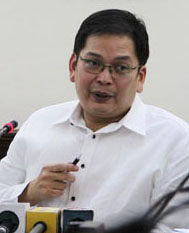
The new leaders of the Philippine Bureau of Customs (BOC) have set targets for changes they want to implement this year and next in the country’s second largest revenue-generating agency.
A document obtained by PortCalls outlines the BOC’s roadmap to achieving reform and transparency as its leadership tries to erase the decades-old public perception that the bureau is the “face of corruption”.
This roadmap will be the subject of discussion at a meeting between Customs Commissioner John Sevilla and various stakeholders on Tuesday (April 29) at the DBP Social Hall in Makati City.
Based on the BOC document, the agency noted it has been able to implement the following measures as of March 2014: revamp the accreditation process for importers and customs brokers; set a reference pricing for steel and resins; and initiate complaints and investigations against 65 examiners and appraisers, with “more to follow”; conducted high-profile smuggling raids; and disallowed rice imports without import permits.
By June this year, the agency intends to complete the implementation of a number of projects, one of which is pre-shipment inspection for all formal entry cargoes, whether containerized or bulk.
Recently, the BOC drafted a customs administrative order requiring a load port survey (LPS) for both containerized and non-containerized import cargoes. Currently, only bulk and breakbulk shipments are required to undergo an LPS.
Other reforms to be completed by June:
- The ability to physically examine 2% of all containers that arrive every day within 72 hours of arrival at all ports. It noted that the percentage of containers that had been x-rayed and had problems were down to 1%;
- Online public disclosures. These would include announcements of public auctions, weekly alert orders, and monthly disclosure of the outcome of alert orders (with names of consignees and brokers for those with negative findings) and seizure cases; and shipments that have not yet been filed for entry or filed but still not cleared;
- The establishment of a Customer Service Department for balikbayan (personal effects of returning Filipinos) boxes and parcels;
- High-profile enforcement actions on intellectual property rights violators and motor vehicles;
- Special procedures for sensitive imports for motor vehicles; and
- A permanent legal basis to pay for overtime work within a reasonable time when it is incurred by employees.
Reforms to be completed by December include:
- Whether in conjunction with the Department of Energy or not, the BOC hopes to have the equipment and expertise to test diesel and gasoline for biodiesel and ethanol to determine whether these fuels are smuggled;
- The agency would also like to have a vessel tracking system independent of the Philippine Coast Guard to provide real-time information on arrivals and departures of vessels at major BOC ports and sub-ports;
- X-rays in all airports that need it;
- A fully electronic submission, processing and storage of formal entries; and
- An enhanced up-and-running National Single Window.
By June 2015, the targets are:
- A full electronic submission, processing and storage system for all entries (informal, export, transshipment documents, and customs bonded warehouse (CBW) transactions and documents, including bonds);
- A single, centralized assessment service;
- A single, centralized valuation reference database, which will be publicly accessible and updated at least every quarter;
- Sale or other disposition of abandoned, seized and forfeited goods within two months of resolution of legal proceedings.
- Fully electronic record keeping for CBWs with real-time access to information about entries, exports, withdrawals and inventories;
- Vessel tracking system extended to all ports and sub-ports;
- Revised operating manual; and
- Key performance indicators to be defined and met for processing time and clearance after full submission of documents; examination of alerted shipments; resolution of valuation disputes; and resolution of seizure cases.
The document said the BOC is at the preparatory stage for some projects. One is the request for additional budget from the Department of Budget and Management for computers, personnel, maintenance and other operating expenses and capital outlay, and examination costs.
Others are procurement of internet coverage for the BOC; employment of additional people with hiring process expected to start in May 2015; and designing and building enhanced electronic platform.
The bureau is still undecided on a few issues, such as whether to extend monitoring of CBWs to Philippine Economic Zone Authority zones and freeports; whether to implement changes in procedures of informal entries; how to monitor and penalize “petty corruption”; and how long it will continue the pre-shipment inspection.
On top of these, BOC has asked “development partners” to help the agency in its reforms in CBW operations; valuation monitoring; analysis of collection and import volume trends with other economic trends; procurement of equipment for the oil determination process; electronic codification of tariff finder, all permits, product registrations, certificates of compliance; and other electronic needs.
More are on the BOC’s list and all consistent with what Sevilla — early in his assignment as head of the BOC — described as reform constituting a series of “unglamorous, operational things”.
Aside from changes in its processes, the BOC had revamped its personnel starting with the designation of new deputy commissioners and followed by the back to mother unit order to all its personnel.
In December last year, the bureau issued a call for individuals who want to be part of the reform of the agency. Several have heeded the call, and the reform wheel has been rolling since then. –– Roumina M. Pablo




